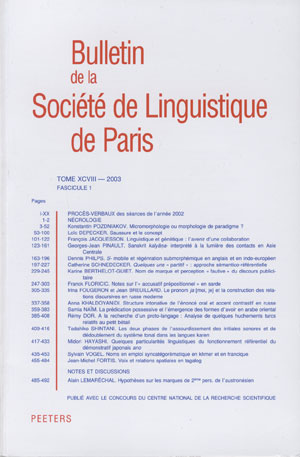 previous article in this issue previous article in this issue | next article in this issue  |

Preview first page |
Document Details : Title: L'instrumental-objet en lituanien Author(s): PETIT, Daniel Journal: Bulletin de la Société de Linguistique de Paris Volume: 107 Issue: 1 Date: 2012 Pages: 285-351 DOI: 10.2143/BSL.107.1.2959707 Abstract : Dans quelques dialectes lituaniens, les adjectifs verbaux en -inas sont employés dans une construction singulière dans laquelle l’accusatif objet est remplacé de manière inattendue par un instrumental, par ex. lit. mótina veda vaikùs «la mère conduit les enfants» (accusatif vaikùs «enfants»), mais lit. mótina eĩna vaikaĩs vedinà «la mère va conduisant les enfants» (instrumental vaikaĩs «enfants»). Dans un article de B. Gliwa, la construction instrumentale est expliquée comme un cas de réanalyse syntaxique à partir d’un instrumental comitatif original «la mère va avec les enfants, (les) conduisant». Si séduisante soit-elle à première vue, cette explication ne peut pas rendre compte des contraintes syntaxiques et sémantiques qui s’avèrent caractéristiques de la construction instrumentale. On peut faire l’hypothèse que cette construction reflète l’ambivalence syntaxique des verbes de mouvement, parfois appelée «alternance locative» dans la littérature typologique. L’«alternance locative» réfère au fait que deux constructions sont possibles avec les verbes de mouvement, une construction locative (par ex. verser de l’eau dans un verre) et une construction instrumentale (par ex. remplir un verre d’eau). Il est possible que le type vaikaĩs vedinà «conduisant les enfants» reflète la construction instrumentale de verbes pour lesquels prédomine habituellement la construction locative. In some Lithuanian dialects, verbal adjectives in -inas are used with an odd construction in which the object accusative is unexpectedly replaced by an instrumental, e.g. Lith. mótina veda vaikùs «the mother leads the children» (accusative vaikùs «children»), but Lith. mótina eĩna vaikaĩs vedinà «the mother goes leading the children» (instrumental vaikaĩs «children»). In a paper by B. Gliwa, the instrumental construction is explained as a case of syntactic reanalysis of an original comitative instrumental «the mother goes with the children, leading (them)». However attractive this explanation might appear at first glance, it cannot account for the syntactic and semantic constraints that turn out to be characteristic of the instrumental construction. It may be argued that this construction reflects the syntactic ambivalence of some motion verbs, sometimes called «locative alternation» in the typological literature. «Locative alternation» refers to the fact that two constructions are possible with some motion verbs, a locative construction (e.g. to pour water into a glass) and an instrumental construction (e.g. to fill a glass with water). It is possible that the type vaikaĩs vedinà «leading the children» reflects the instrumental construction of verbs in which the locative construction usually predominates. In einigen litauischen Dialekten weisen die Verbaladjektive auf -inas eine seltsame Konstruktion auf, in der ein Akkusativ des Objekts unerwarteterweise durch einen Instrumental ersetzt wird, z.B. lit. mótina veda vaikùs «die Mutter führt die Kinder» (Akk. vaikùs «Kinder»), aber lit. mótina eĩna vaikaĩs vedinà «die Mutter geht die Kinder führend» (Instr. vaikaĩs «Kinder»). In einem Aufsatz von B. Gliwa wird die Instrumentalkonstruktion als ein Fall der syntaktischen Reanalyse aufgrund eines ursprünglichen Komitativ-Instrumentals «die Mutter geht mit den Kindern, (sie) führend» erklärt. Wie attraktiv diese Deutung auch immer erscheinen mag, vermag sie die syntaktischen und semantischen Beschränkungen, die sich als charakteristisch für die Instrumentalkonstruktion erweisen, nicht zu erklären. Man kann vermuten, dass diese Konstruktion die syntaktische Ambivalenz der Bewegungsverben, die in der typologischen Literatur gelegentlich «Lokativalternanz» genannt wird, widerspiegelt. Unter «Lokativalternanz» versteht man die Tatsache, dass bei Bewegungsverben zwei Konstruktionen möglich sind, eine Lokativkonstruktion (z.B. Wasser in ein Glas giessen) und eine Instrumentalkonstruktion (z.B. ein Glas mit Wasser füllen). Es ist möglich, dass der Typ vaikais vedinà «die Kinder führend» die Instrumentalkonstruktion von Verben, in denen die Lokativkonstruktion normalerweise vorherrscht, widerspiegelt. |
|


